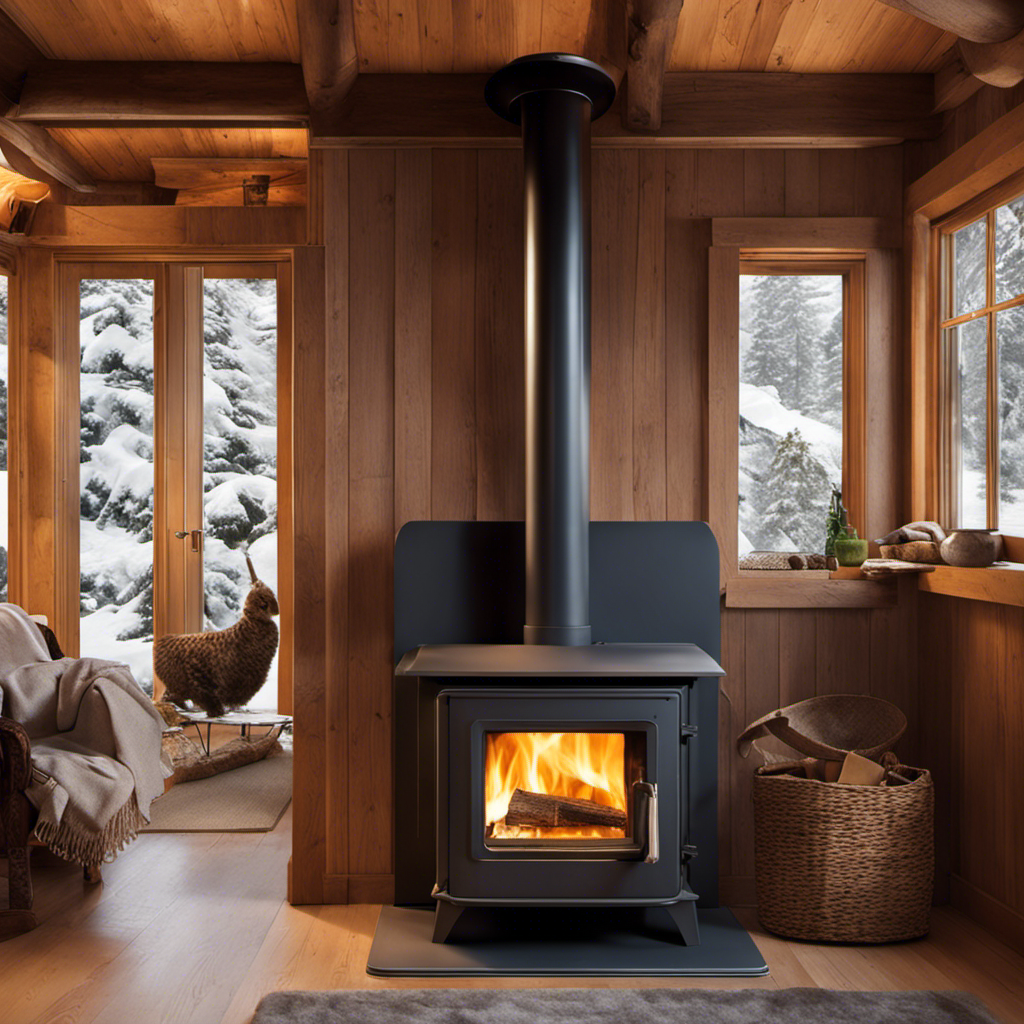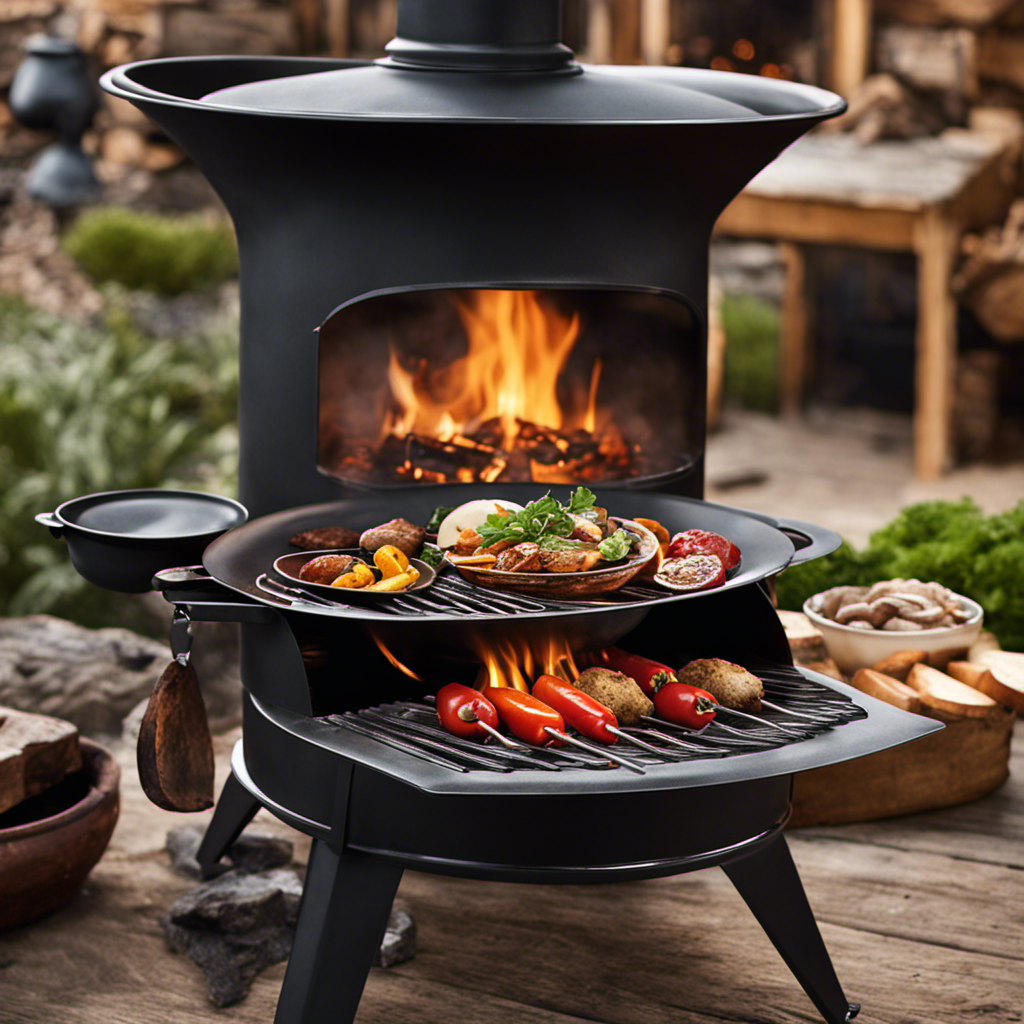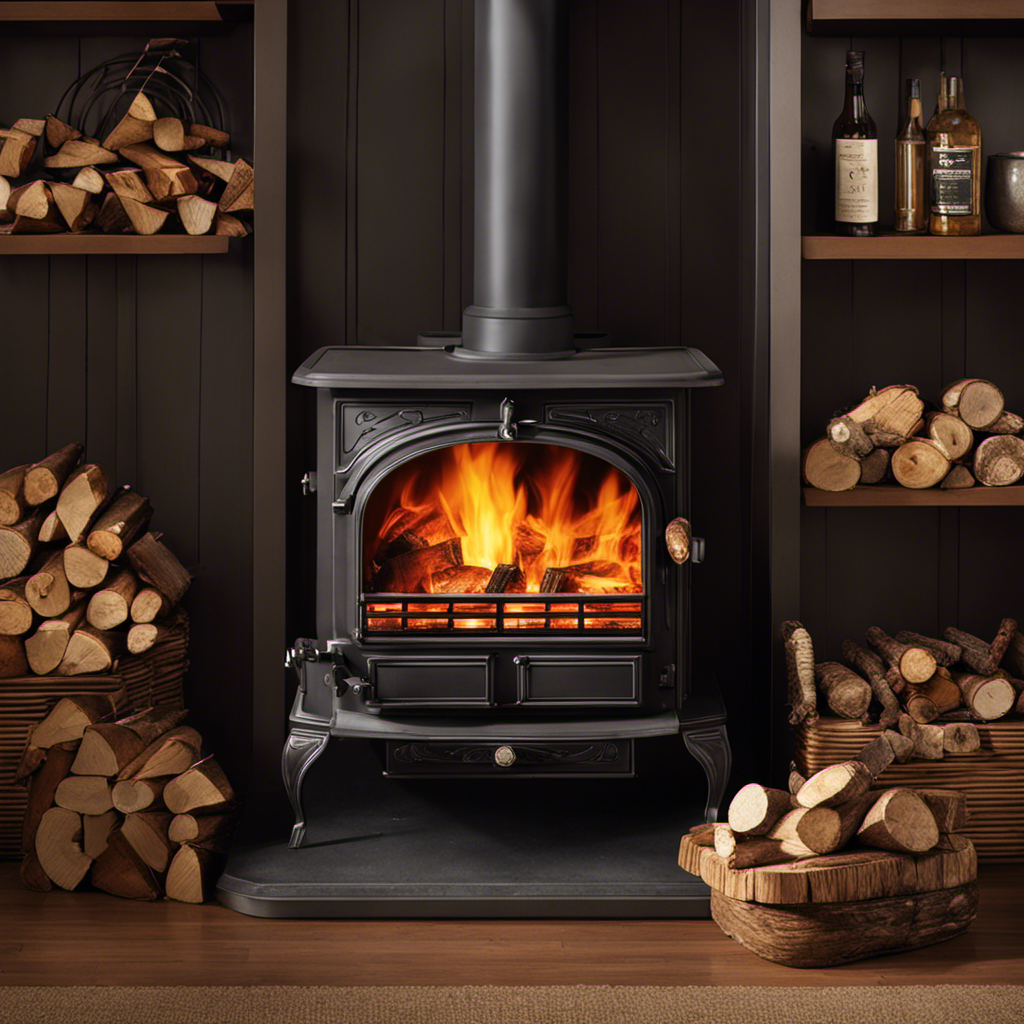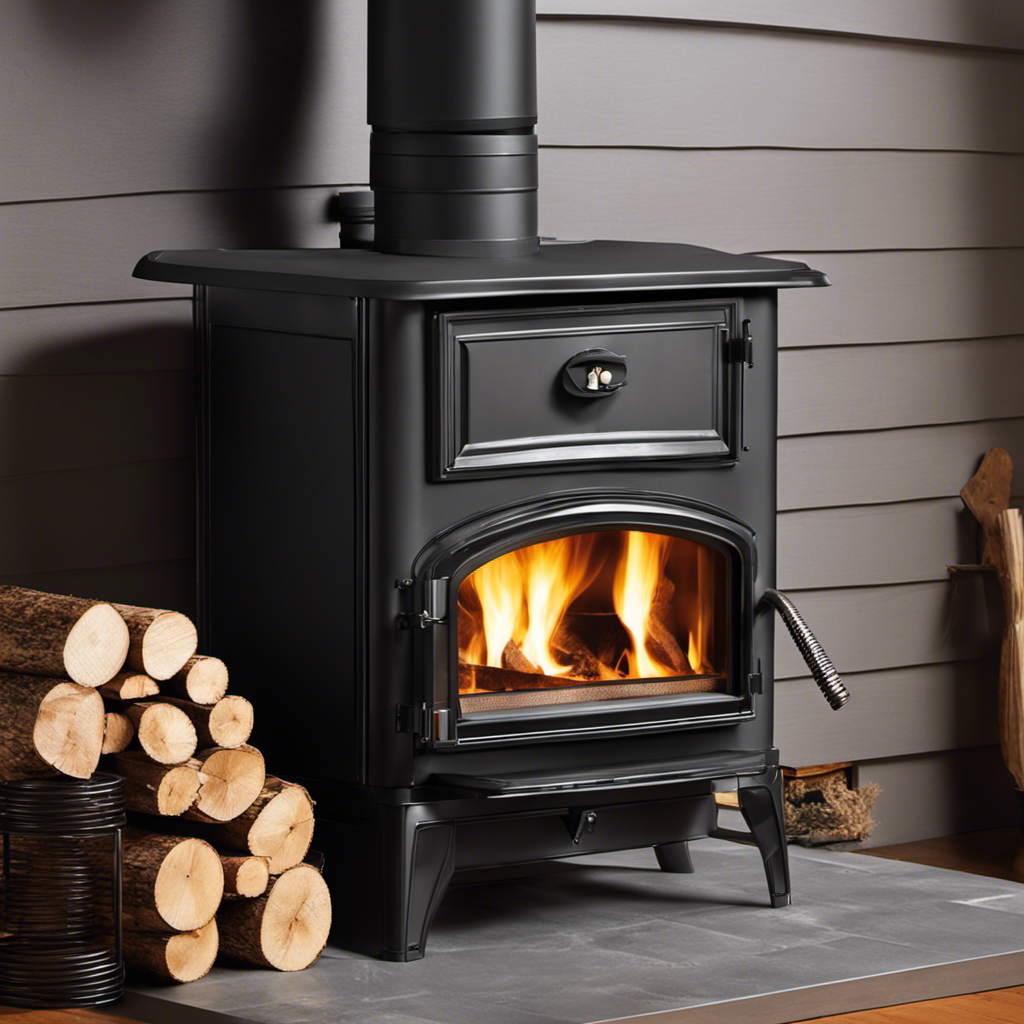Tired of your wood stove consuming too much energy and harming the environment? Fear not! We’ve got the answers you’ve been seeking.
In this article, we’ll reveal the best practices for maintaining an eco-friendly wood stove efficiently. By following these simple steps, you can reduce your carbon footprint and save money in the process.
Get ready to revolutionize your wood stove experience and join the movement towards a greener, more sustainable future.
Key Takeaways
- Schedule regular cleaning and maintenance for the wood stove
- Select dry and seasoned wood for optimum performance
- Use efficient fire building techniques to achieve optimal heat output and minimal waste
- Regularly inspect and clean the chimney for proper ventilation
Regular Cleaning and Maintenance
We make sure to schedule regular cleaning and maintenance for our wood stove to ensure it stays efficient and eco-friendly. Proper ash disposal is an essential part of this routine. After each use, we carefully remove the ashes and dispose of them in a designated metal container. This prevents any potential fire hazards and helps maintain optimum stove performance.
Chimney maintenance is another crucial aspect of keeping our wood stove eco-friendly. We inspect the chimney regularly for any blockages or buildup of soot and creosote. By cleaning the chimney periodically, we ensure proper ventilation and prevent any potential carbon monoxide leaks. Additionally, we check for any cracks or damages that may require repairs.
Proper Fuel Selection and Storage
To ensure optimum performance and minimize environmental impact, we carefully select and store our fuel by using dry and seasoned wood, along with proper storage techniques.
Fuel efficiency is crucial in maintaining an eco-friendly wood stove, and selecting the right type of wood is key. Dry wood burns more efficiently and produces fewer emissions, reducing the stove’s environmental impact.
It’s important to store the wood in a dry and well-ventilated area, away from moisture, to prevent it from becoming damp and less efficient.
Regularly inspecting and cleaning the stove’s flue and chimney also improves fuel efficiency and reduces the release of harmful pollutants.
Efficient Fire Building Techniques
Using proper kindling and arranging the logs strategically can significantly improve the efficiency of our fire. When it comes to building a fire in our wood stove, there are a few key techniques we can employ to ensure optimal heat output and minimal waste.
Here are three efficient fire building techniques that can help us achieve this goal:
-
Use dry, seasoned wood: Moisture content in wood can greatly affect its burn efficiency. It’s important to use well-seasoned firewood with a moisture content of around 20% or less. This will ensure a cleaner burn and reduce the amount of smoke produced.
-
Build a proper fire lay: Start by placing a layer of small, dry kindling at the bottom of the stove. Then, stack larger pieces of wood in a crisscross pattern, allowing for proper airflow. This will promote better combustion and more efficient heat transfer.
-
Maintain proper air intake: Adjusting the air vents on our wood stove can help control the rate of combustion. By keeping the intake vent open enough to provide adequate oxygen, we can ensure a steady and efficient burn.
By practicing these efficient fire building techniques and regularly maintaining our wood stove, we can maximize its performance while minimizing our impact on the environment.
Together, let’s strive for an eco-friendly and liberating wood stove experience.
Adequate Airflow Control and Regulation
Properly regulating and maintaining airflow is crucial for ensuring efficient wood stove operation and preventing potential safety hazards.
Adequate airflow management is essential for achieving optimal fuel efficiency and reducing harmful emissions. To achieve this, it’s important to keep the air vents clean and free from obstructions.
Regularly inspecting and cleaning the chimney is also necessary to ensure proper ventilation.
Additionally, using the correct type and size of firewood can greatly impact airflow and efficiency. Dry and seasoned hardwoods are ideal for producing a clean and efficient burn.
It’s also recommended to use a wood stove fan or blower to help distribute heat more evenly and improve overall performance.
Can the Maintenance Practices for an Outdoor Wood Stove for Cooking Also Apply to an Eco-Friendly Wood Stove?
Yes, the maintenance practices for an outdoor wood stove for cooking can also apply to an eco-friendly wood stove. Regularly maintaining outdoor wood stoves, such as cleaning the chimney, removing ash, and inspecting for any damage, will help ensure the long-term efficiency and durability of eco-friendly wood stoves.
Regular Inspection and Professional Servicing
We always make sure to schedule regular inspections and hire professionals for servicing our wood stove. Maintaining an eco-friendly wood stove efficiently is crucial for both the environment and our own safety. Here are three best practices to follow:
-
Regular professional inspection: By having a professional inspect your wood stove regularly, you can identify and address any potential issues before they become major problems. This ensures that your stove is functioning properly and efficiently.
-
Thorough cleaning and servicing: Professional servicing includes cleaning the stove, removing any built-up creosote, and checking for any damaged parts. This not only improves the stove’s performance but also prevents the risk of chimney fires.
-
Proper use and maintenance: It’s important to use your wood stove correctly and follow any manufacturer’s guidelines for maintenance. This includes using dry and seasoned wood, avoiding overloading the stove, and regularly cleaning the stovepipe and chimney.
Frequently Asked Questions
Are There Any Specific Types of Wood That Should Be Avoided When Using a Wood Stove for Eco-Friendly Purposes?
When using a wood stove for eco-friendly purposes, it is important to avoid burning pressure treated wood, as well as painted or stained wood. These types of wood can release harmful chemicals into the air and harm the environment.
How Can I Ensure That My Wood Stove Is Burning Efficiently and Not Releasing Excessive Smoke or Pollutants?
To reduce smoke and pollutants from a wood stove, we can follow these tips for maintaining an eco-friendly wood stove efficiently. Regularly clean the stove and chimney, use dry and seasoned wood, and ensure proper airflow for efficient burning.
Are There Any Additional Accessories or Tools That Can Help Improve the Efficiency of a Wood Stove?
Installing a stove fan and using a catalytic converter are two additional accessories that can greatly improve the efficiency of a wood stove. These tools help distribute heat more effectively and reduce emissions for a more eco-friendly wood burning experience.
What Steps Can Be Taken to Reduce the Amount of Ash and Creosote Buildup in a Wood Stove?
To reduce ash and creosote buildup in a wood stove, we can follow some steps. Regularly clean the stove and chimney, burn dry and seasoned wood, and choose eco-friendly wood that produces less residue.
Is It Possible to Retrofit an Existing Wood Stove to Make It More Eco-Friendly, and if So, What Are Some Recommended Modifications?
Yes, it is possible to retrofit an existing wood stove to make it more eco-friendly. Some recommended modifications include adding a catalytic converter, improving insulation, and using a pellet insert. These changes can provide advantages such as increased efficiency and reduced emissions.
Conclusion
In conclusion, maintaining an eco-friendly wood stove efficiently requires regular cleaning. This includes removing ash and soot buildup to prevent blockages and ensure optimal airflow. Additionally, proper fuel selection is crucial. Using dry, seasoned wood that has been properly stored will produce cleaner and more efficient combustion.
Efficient fire building techniques are also essential. Building a small, hot fire with properly arranged logs will promote complete combustion and reduce emissions. It is important to avoid overloading the stove with too much wood, as this can lead to smoldering and incomplete burning.
Adequate airflow control is another important factor in maintaining an eco-friendly wood stove. Adjusting the stove’s air vents to control the amount of oxygen entering the firebox will help achieve efficient combustion. It is crucial to find the right balance between too much and too little airflow to optimize burning conditions.
Regular inspection of the wood stove is necessary to ensure its proper functioning and efficiency. Checking for any cracks or leaks in the stove, as well as inspecting the chimney and flue, will help identify and address any potential issues. Addressing these problems promptly will prevent energy waste and reduce the risk of carbon monoxide leaks.
By following these practices, you can enjoy a cozy and environmentally-friendly home heating experience. Regular cleaning, proper fuel selection, efficient fire building techniques, adequate airflow control, and regular inspection will ensure that your wood stove operates at its best, reducing emissions and maximizing heat output.
So, stay savvy and sustainably warm!
Growing up surrounded by the vast beauty of nature, Sierra was always drawn to the call of the wild. While others sought the comfort of the familiar, she ventured out, embracing the unpredictable and finding stories in the heartbeat of nature.
At the epicenter of every remarkable venture lies a dynamic team—a fusion of diverse talents, visions, and passions. The essence of Best Small Wood Stoves is crafted and refined by such a trio: Sierra, Logan, and Terra. Their collective expertise has transformed the platform into a leading authority on small wood stoves, radiating warmth and knowledge in equal measure.











